A year or so ago casting around for new challenges, I google’d “barefoot Grand Canyon,” and that’s when I discovered Thea Gavin, a free-spirited writer and self-styled “suburbanite chronically injured running grandma,” who’d hiked from one rim of the Grand Canyon to the other, descending roughly 5,000 feet and them climbing back out, for a total journey of 24 miles, all without shoes. When conventional boot-clad hikers in the Canyon asked why, she responded, “It’s fun.”
This spring I began planning a western trip to the Grand Canyon and other places I’d never been. Business matters interceded, the trip was delayed, put on hold, and then finally thrown together at the last minute with destinations to be figured out on the fly.
Now it’s late morning, August 7, and I’m pulling in to Kanab, Utah, which I’ve designated as my final staging point prior to entering Grand Canyon National Park. Priority of work: lunch, laundry, gas, obtain a wi-fi connection to download maps and review the route, and hopefully find an espresso. The strategy is to enter the park after dark (avoiding the crowds and the heat), attempt a barefoot descent of the Bright Angel Trail to the Colorado River, and then turn around and climb back up.
The work in Kanab gets completed quickly, there’s not much point in hanging around, so I advance the timetable and move further south. A three hour drive takes me through the hazy yellow desert plains of southern Utah, temperature peaking at 103 F. Windows down and air conditioning off, to help me acclimate to the desert environment. It will be even hotter, it occurs to me, deep in the Canyon.
A flash of metallic blue in the distance: man-made Lake Powell beneath cliffs of tan and orange, the Navajo and Entrada sandstone formations familiar from Moab. The desert keeps changing, and later on I’m driving past piles of brown and white rocks.

Nearing the Canyon, I’m startled by the sight of the Little Colorado River: a deep gash in flat scrub plains, like a hatchet wound. I try to imagine people walking through the desert thousands of years ago, and suddenly they encounter this 3,000-foot trench and can proceed no further.
Meanwhile a huge hazy cloud lying along the horizon is bubbling up and obscuring distant ridges and half the sky. Smoke, I learn, from a controlled burn.
Pulling into a large parking area, I elbow my way through a crowd of tourists to a vantage point and for the first time look down into the Grand Canyon. Late afternoon sunlight playing against a yellow-orange sandstone slope, distant ridges shading to blue, smoke from the burn hanging in the air and giving the scene a tinge of desolation, like a view of Mordor from Lord of the Rings.
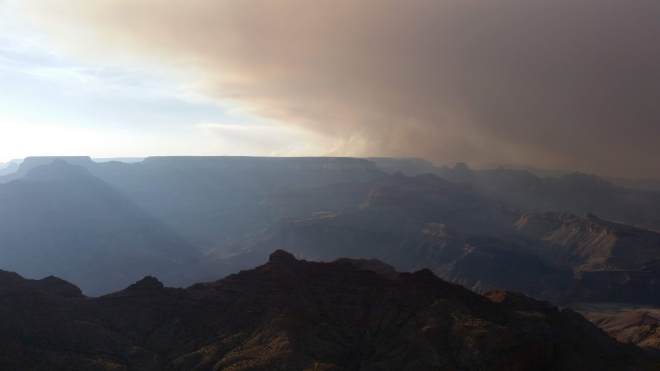
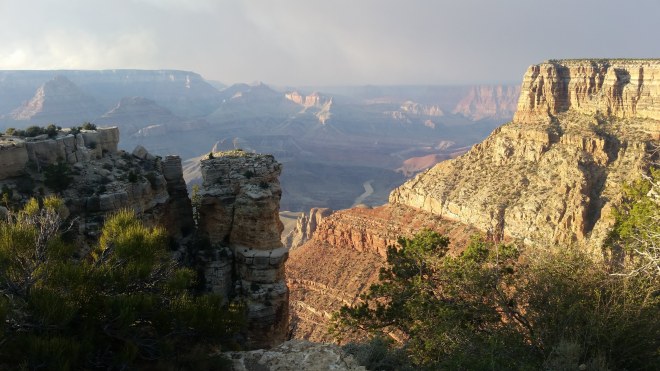
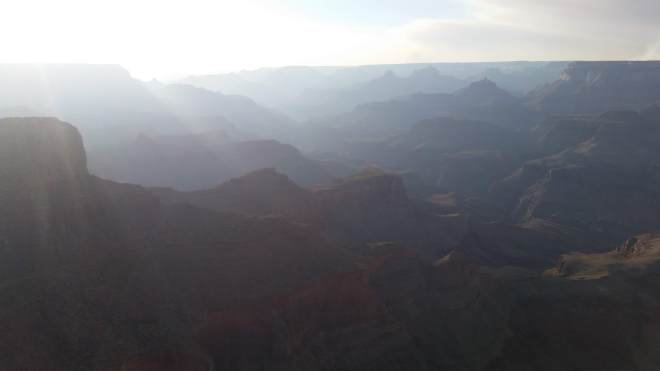
Heat, altitude, distance, the magnitude of the climb, rough footing, scorpions and other unfriendly critters, and my unfamiliarity with the Canyon are concerns. After grabbing dinner at one of the village lodges, I type up an action plan on my laptop, complete with goals, risk assessment, observations on the route, and an updated weather forecast for the top and the bottom of the Canyon. The temperature in Bright Angel Campground is projected to increase from 71 F at 5:00 AM to 97 F by 10:00 AM and peak at 107 F. The plan is to reach bottom and turn around no later than 8:00 AM.
It’s 11:00 PM, I’m sitting in my rental vehicle, final checks complete, listening to music.
T – 15 minutes, sitting on a rock at the trailhead, waiting for the stroke of midnight. The temperature is mild, a dry wind blows across the rim, faint scent of sage and smoke. Some coyotes yipping off to the south. To the north, points of red light, the remains of the controlled burn, smoldering. No moon. The Milky Way spread across dark sky.
And now my phone shows 12:00. I peel off shoes and socks, toss them in the pack, and off I go, wondering what I’ll find. Park Service materials describe Bright Angel as “a maintained dirt trail,” and after the first few steps, it’s actually quite pleasant: not really dirt but rather sand, deep and soft, a pleasant surprise. Some rocks and gravel, just enough to make you pay attention. I could run, but that’s not the plan. Instead I creep along, careful not to lose my balance and come down hard on a sharp rock or bang a toe. A slow pace, but steady, and after a little while, here’s a sign in the beam of my headlamp pointing to restrooms and water: it’s the 1.5-mile rest stop.
Crickets chirp from the trees or call continuously from the bushes, and here’s one of the little fellows on the trail caught in the beam of my light, motionless. A few steps later the light reveals another dark shape: a small scorpion, also motionless.


A party of three young ladies is on their way up, one of them wearing an Air Force t-shirt, so I ask is she on active duty, and the answer is, “yes, sir.” About to finish her bachelor’s degree, she’s going to apply for officer candidate school. The best officers have enlisted experience I tell her.
Three miles comes and goes. Another rest stop, another sign. It’s the middle of the night now, and no-one’s out here but me. I’m struggling a little with thick logs pinned to the ground every few feet, no doubt to prevent erosion, they force me to lift my feet up and over and then lower myself down six inches or sometimes a foot. Stepping over them is like doing single-leg squats, an exercise that a physical therapist recommended to strengthen my quadriceps tendon, but probably not intending for me to do repetitions all night.
Darkness is not helping my sense of balance. I start programming in rest breaks every thirty minutes, to give me something to aim for and a chance to clear the head. Turn off light and look at stars, feel the breeze, check the map, sip some water.

Now the light catches another scorpion, but this one’s much larger and scurrying across the trail, yellow tail arched and pincers raised, looking for a fight it seems — and hopefully not with me. I move right along.
Around 3:00 AM, a southerly wind picks up — it’s quite strong, blowing sand along the trail, the grains whipping my legs and waist and sometimes the back of my head. As I pass the Indian Garden campground, the wind rushes loudly through trees. They’re not visible in the dark, but the leaves sound like cottonwoods, and indeed there’s a cottonwood leaf lying on the trail. The wind blows so forcefully, it flattens a patch of reeds against the ground. I stare at the red dots smoldering in the north, which are surely waxing brighter.
You’d think that deeper in the canyon, the path would become sandier, but actually there seem to be more rocks. In one of her posts, Thea Gavin advised barefoot runners to let their feet relax. Conform to the rocky surface, don’t fight it. This advice helps me a lot. But still each step takes full concentration, and I’m moving very slowly.
As the trail continues to descend, my light shines against hard-edged granite with seams of quartz. This is not sandstone, and the trail is not covered in sand but rather a mix of pink and blue gravel. I suspect, and later confirm, the pink is Zoroaster Granite and the blue, Vishnu Schist, formations that are approximately two billion years old. My tender feet are no match for this.

A little before 5 AM, I start crossing paths with a steady stream of people heading up early to avoid the heat. As the day lightens and people notice my feet, I start getting comments. “You must be brave!” (appreciated, even if untrue). “You’re not wearing shoes!” (factually accurate, hard to dispute). “Why?” to which I respond, “it’s fun.”
To some extent, I enjoy surprising people. My role is like that of a scout who brings back a report from distant lands of more things in heaven and earth than are dreamed of in popular philosophies. But too many questions get tiresome.
A young fellow with a camouflage rucksack asks what happened to my shoes. Somewhat obscurely, “They’re around here somewhere.”
A moment later he comes back, worried that I’ve lost them. I reassure him they’re in my pack. Then I ask what unit he belongs to. He’s a Ranger – not a Park Service Ranger — rather a U.S. Army Ranger, serving in one of the battalions, which means he’s a paratrooper, a crack shot, trained to cover long distances with a heavy load, endure lack of sleep and food, accomplish the mission no matter how difficult, never give up. Having served in a Ranger Battalion some thirty years ago, I give him the standard greeting, “Rangers lead the way.” He’s too startled to respond (“All the way”).
We talk for a bit, then I wish him good luck in his coming deployment and watch as he strides off down the trail in the early morning light. What a delight to meet a young person who’s volunteered for difficult duty, someone willing to stand up and make a difference. I really want to do something to help him, but what could I do? The encounter makes me wonder, how does an older person stay relevant to the next generation?
No answer presents itself. A little later, the Colorado River comes into sight. I planned to take a dip, but signs warn of dangerous currents.
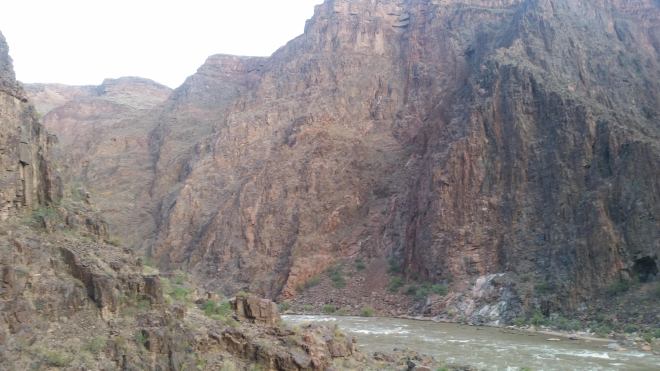
The sun’s over the ridge and shining in my face by the time I reach the bridge. I hobble across, feet smarting on the metal lattice, and stumble into the Bright Angel Campground, my turn-around point, just about whipped.
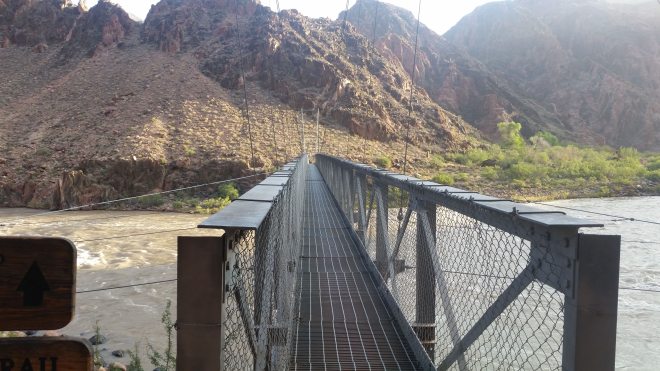
I’d like to stay barefoot for the climb back out – just like Thea Gavin – but that’s not going to happen today, especially with the turn-around time approaching and the temperatures down here soon to begin rising. When hiking barefoot, you delegate decisions about speed to the the soles of your feet. If you don’t listen, then you’re asking for aggravation, frustration, missteps, and injury. Yes, I have experience with all of the above.
Plus enough of this slow creeping pace, it’s time to go a little faster. One day, perhaps, I’ll be barefoot and fast, but for now, it’s one or the other. So the shoes go on, and the trekking poles come out, and now with the sun up, it’s time for shirt, desert hat, armbands, sunscreen, sunglasses. All those people asking “why,” the answer is “because,” and now it’s time to catch back up and pass them and leave them them in the Zoroaster, Vishnu, and sandstone dust.
What a joy to push the throttle forward and begin moving forward and up — and here’s another reason to get going: mule train at 6:00 o’clock and closing.
It takes a long time to reach the first three hikers, after all we’d crossed paths almost three hours earlier. After another hour, though, I’ve passed twenty-eight of them, and reaching the Indian Garden Campground I lose count, because there are so many milling around. You could question whether it’s a fair contest, since many of these hikers have heavy overnight packs, and none seems in a hurry, but that’s their problem, not mine.
A man comes trotting down the trail, followed by a bunch of kids. A little later, he passes me on his way back up. I call out, “Cross-country or track?” Smiling, he’s a cross-country coach. “I want to try out for your team!” I shout, digging in with the poles, picking up the pace, but there’s no way I can keep up.
But I do gain on one of his young charges. “You’ve got a good coach,” I comment, “do what he says, and he’ll train you to run fast.” The kid thinks about this for a second and responds, “yes, he’s a great coach.”
Passing a high-school runner is a small triumph, but also a costly one. Back in the day, I ran 100-mile races in the mountains, sometimes covering in excess of 30,000 feet in cumulative elevation gain, but today’s 4,500-foot climb is as much as I’ve done in a while, and muscles are beginning to fatigue. I focus on engaging gluteus maximus and upper hamstrings, keeping pressure off of quadriceps tendon and knees.
The sun’s way up in the sky now, and I’m starting to feel the heat. Watch shows heart rate increasing from 120 beats per minute to 130. . . and then to 135. That’s high enough (core temperature is correlated to exertion, not hydration). Pulling over in the shade of a rock outcropping, I sip some water, let the heart rate settle.
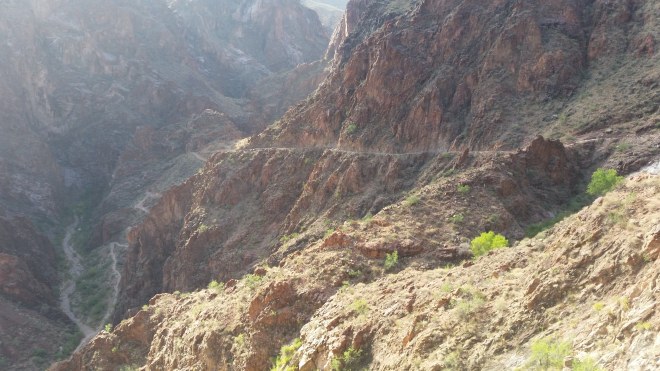
The last mile I’m pushing as hard as I can, even running a few steps near the top, weaving through the hordes of tourists milling about. It took me seven hours to descend, and four to get back up.
Back on the rim I stumble a few steps forward and bump into the coach. His name is Justin, he’s in his early 40’s, and he’s brought his high school cross country team here from Los Angeles. We talk about running, and Justin mentions he recently finished his first 100-miler. I congratulate him on this achievement, my voice still raspy with exertion, and go on to thank him for the good work he’s doing with young people, teaching them to train hard and run fast, and leading by example. It seems like so many of the younger generation are disappearing into their devices….one hopes they aren’t getting lost in the matrix. Justin’s been coaching cross-country for 17 years, and yes, with each passing year it’s harder to recruit new team members, he observes, the kids seem less interested in physical activity.
I walk off and sit in the shade for a few minutes, admiring the views, wondering how an older person stays relevant to the younger generation. I didn’t run cross-country in high school, and, honestly, I’m a bit old to try out for Justin’s team. Instead, I will try to learn from people like Thea Gavin, and possibly follow her example and attempt a complete barefoot crossing of the Canyon next time I’m here.
I wobble back to the car, return to the lodge for a hamburger, drink not one, but two espressos, and fall asleep at the table.
Running the Long Path is available on Amazon (Click on the image to check it out)
[…] I am thrilled and honored that author/adventurer Kenneth Posner discovered my barefoot Grand Canyon antics (as chronicled regularly on this blog), and that my barefoot wandering and writing helped him in some small way with his own first excursion at Grand Canyon earlier this month. […]
LikeLike
Awesome trip and report Ken! I’d never try it barefoot. After experiencing the canyon for the first time in a R3 adventure, I’m convinced that pictures and words can’t do it justice. I started almost the same time as you but struggled through the heat on the return trip.
LikeLiked by 1 person
[…] barefoot hiking in Arches National Park, Canyonlands, Coral Pink Sand Dunes State Park, the Grand Canyon, and […]
LikeLike